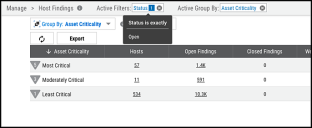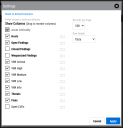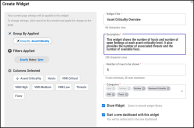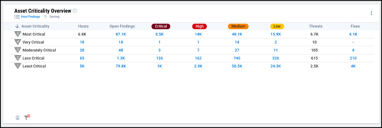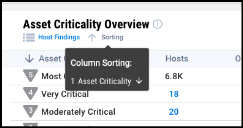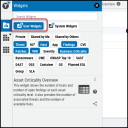User Widgets: Overview
Summary: A guide on how to make a widget based on current page configurations.
This article describes how you can create a widget based on your current page configurations. A "user" or widget captures your column selections, sort order, applied filters, and applied Group By. Once you create the widget, you can add it to your dashboards and share the widget with other users on your client.
You can currently create a user widget on these pages:
-
Host Findings
-
Application Findings
-
Hosts
-
Applications
-
Groups
-
Patches
Creating a Widget
Prior to creating a widget, consider which columns you need to effectively tell your story. Determine if you want to apply a Group By and filters.
In this example, the widget should provide an overview of hosts at each business criticality. It should also show open findings, threats, and fixes. To make this widget, you could apply the Asset Criticality Group By to the Host Findings page and restrict the list to only open findings. The widget should also show the highest criticality to the lowest criticality by sorting on the Asset Criticality column.
Once you have decided on your filters and decided whether to aggregate the data, configure your page settings to reorder or disable columns. All columns that you currently have enabled will appear in the final widget.
To reorder the results, click the header of the column that should sort the data. If you have not applied a Group By, you can also apply a multi-column sort.
You will see a new button on each page labeled Create Widget next to the Group By button. Click it to open the Create Widget dialogue.
You can review your visible columns, filters, Group By, and sort options on the left of the Create Widget dialogue. On the right, you can define the title, description, and the number of rows that the widget should show by default.
The system always assigns at least one category to a user widget. For example, all widgets that you create on the Host Findings page have the "Host" and “Findings” labels. You can add additional categories that reflect the widget content.
When you save, you can share it immediately with other users.
You can also choose to add the widget to a new dashboard. The system will automatically redirect you to the new dashboard once you save the widget.
Interacting with a User Widget
User widgets preserve many of the features of the Ivanti Neurons RBVM/ASPM/VULN KB page views. They show the same columns and support many of the clickable links. (You will see disabled links if the original links open specific sections of the Detail pane on the original page).
If you want to recreate the original page view, click the blue link under the title. The link will configure the page to match the widget. However, you have access to the full list of results and can perform actions such as tagging items and adding findings to workflows.
If you hover your mouse over Sorting, you can review what columns sort the widget. Not all the columns may be visible.
The icons on the bottom left tell you who has shared the widget and notify you that dashboard filters have no impact on the widget. Users widgets ignore the dashboard-level Tag, Network, and Group filters.
If you click the 3-dot menu, you can rename this instance of the widget, edit its description, or change the number of rows that it shows.
Finding Your User Widget
Open the gallery and click the User Widgets category. The widget also shows up if you search for it by name or click one of the other widget categories that you have applied to it.
Private widgets appear under the Private tab. You can add your private widgets to any of your private dashboards. Your shared widgets show up under the Shared by You tab.
Editing Your User Widget
If you want to update your widget, you can access its original settings from the widget itself or from the widget gallery. You can modify any widget other than for those based on the Patches page. For more information, visit the article on editing user widgets.
Saving and Sharing
Widgets can either be private to you or shared with other users on the same client. For more information on managing widgets, see the article on sharing user widgets.
